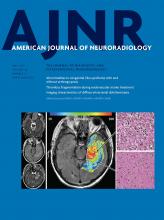Index by author
Gailloud, P.
- FELLOWS' JOURNAL CLUBSpine Imaging and Spine Image-Guided InterventionsYou have accessIntraforaminal Location of Thoracolumbar Radicular Arteries Providing an Anterior Radiculomedullary Artery Using Flat Panel Catheter AngiotomographyL. Gregg, D.E. Sorte and P. GailloudAmerican Journal of Neuroradiology May 2017, 38 (5) 1054-1060; DOI: https://doi.org/10.3174/ajnr.A5104
Ninety-four flat panel catheter angiotomography acquisitions obtained during the selective injection of intersegmental arteries providing an anterior radiculomedullary artery were reviewed. The location of radicular arteries could be ascertained in 78/94 flat panel catheter angiotomography acquisitions. Fifty-three acquisitions (67.9%) were on the left side, and 25 (32.1%), on the right, between T2 and L3. The arteries were found in the anterosuperior quadrant in 75 cases (96.2%), in the posterosuperior quadrant in 2 (2.6%), and in the anteroinferior quadrant in 1(1.3%). Needle placement in the anterosuperior quadrant (subpedicular approach) should be avoided during transforaminal epidural steroid injection. The authors advocate the posterolateral approach that allows placing the needle tip away from the documented position of ARMA contributors within the neural foramen, reducing the risk of intra-arterial injection or injury to the spinal vascularization.
Gialdini, G.
- Adult BrainOpen AccessQuantifying Intracranial Internal Carotid Artery Stenosis on MR AngiographyH. Baradaran, P. Patel, G. Gialdini, K. Al-Dasuqi, A. Giambrone, H. Kamel and A. GuptaAmerican Journal of Neuroradiology May 2017, 38 (5) 986-990; DOI: https://doi.org/10.3174/ajnr.A5113
Giambrone, A.
- Adult BrainOpen AccessQuantifying Intracranial Internal Carotid Artery Stenosis on MR AngiographyH. Baradaran, P. Patel, G. Gialdini, K. Al-Dasuqi, A. Giambrone, H. Kamel and A. GuptaAmerican Journal of Neuroradiology May 2017, 38 (5) 986-990; DOI: https://doi.org/10.3174/ajnr.A5113
Gill, B.J.A.
- EDITOR'S CHOICEAdult BrainYou have accessA Multiparametric Model for Mapping Cellularity in Glioblastoma Using Radiographically Localized BiopsiesP.D. Chang, H.R. Malone, S.G. Bowden, D.S. Chow, B.J.A. Gill, T.H. Ung, J. Samanamud, Z.K. Englander, A.M. Sonabend, S.A. Sheth, G.M. McKhann, M.B. Sisti, L.H. Schwartz, A. Lignelli, J. Grinband, J.N. Bruce and P. CanollAmerican Journal of Neuroradiology May 2017, 38 (5) 890-898; DOI: https://doi.org/10.3174/ajnr.A5112
Ninety-one localized biopsies were obtained from 36 patients with glioblastoma. Signal intensities corresponding to these samples were derived from T1-postcontrast subtraction, T2-FLAIR, and ADC sequences by using an automated coregistration algorithm. Cell density was calculated for each specimen by using an automated cell-counting algorithm. T2-FLAIR and ADC sequences were inversely correlated with cell density. T1-postcontrast subtraction was directly correlated with cell density. The authors conclude that the model illustrates a quantitative and significant relationship between MR signal and cell density. Applying this relationship over the entire tumor volume allows mapping of the intratumoral heterogeneity for both enhancing core and nonenhancing margins.
Gillard, J.H.
- Adult BrainOpen AccessCan MRI Visual Assessment Differentiate the Variants of Primary-Progressive Aphasia?S.A. Sajjadi, N. Sheikh-Bahaei, J. Cross, J.H. Gillard, D. Scoffings and P.J. NestorAmerican Journal of Neuroradiology May 2017, 38 (5) 954-960; DOI: https://doi.org/10.3174/ajnr.A5126
Glodny, B.
- Extracranial VascularYou have accessSelective-versus-Standard Poststent Dilation for Carotid Artery Disease: A Systematic Review and Meta-AnalysisO. Petr, W. Brinjikji, M.H. Murad, B. Glodny and G. LanzinoAmerican Journal of Neuroradiology May 2017, 38 (5) 999-1005; DOI: https://doi.org/10.3174/ajnr.A5103
Graves, M.
- You have accessReply:J. Yuan and M. GravesAmerican Journal of Neuroradiology May 2017, 38 (5) E37; DOI: https://doi.org/10.3174/ajnr.A5146
Greenwell, C.
- You have accessReply:T.N. Booth, R. Jacob, C. Greenwell, K. Reeder and K. KoralAmerican Journal of Neuroradiology May 2017, 38 (5) E31; DOI: https://doi.org/10.3174/ajnr.A5111
Gregg, L.
- FELLOWS' JOURNAL CLUBSpine Imaging and Spine Image-Guided InterventionsYou have accessIntraforaminal Location of Thoracolumbar Radicular Arteries Providing an Anterior Radiculomedullary Artery Using Flat Panel Catheter AngiotomographyL. Gregg, D.E. Sorte and P. GailloudAmerican Journal of Neuroradiology May 2017, 38 (5) 1054-1060; DOI: https://doi.org/10.3174/ajnr.A5104
Ninety-four flat panel catheter angiotomography acquisitions obtained during the selective injection of intersegmental arteries providing an anterior radiculomedullary artery were reviewed. The location of radicular arteries could be ascertained in 78/94 flat panel catheter angiotomography acquisitions. Fifty-three acquisitions (67.9%) were on the left side, and 25 (32.1%), on the right, between T2 and L3. The arteries were found in the anterosuperior quadrant in 75 cases (96.2%), in the posterosuperior quadrant in 2 (2.6%), and in the anteroinferior quadrant in 1(1.3%). Needle placement in the anterosuperior quadrant (subpedicular approach) should be avoided during transforaminal epidural steroid injection. The authors advocate the posterolateral approach that allows placing the needle tip away from the documented position of ARMA contributors within the neural foramen, reducing the risk of intra-arterial injection or injury to the spinal vascularization.
Grinband, J.
- EDITOR'S CHOICEAdult BrainYou have accessA Multiparametric Model for Mapping Cellularity in Glioblastoma Using Radiographically Localized BiopsiesP.D. Chang, H.R. Malone, S.G. Bowden, D.S. Chow, B.J.A. Gill, T.H. Ung, J. Samanamud, Z.K. Englander, A.M. Sonabend, S.A. Sheth, G.M. McKhann, M.B. Sisti, L.H. Schwartz, A. Lignelli, J. Grinband, J.N. Bruce and P. CanollAmerican Journal of Neuroradiology May 2017, 38 (5) 890-898; DOI: https://doi.org/10.3174/ajnr.A5112
Ninety-one localized biopsies were obtained from 36 patients with glioblastoma. Signal intensities corresponding to these samples were derived from T1-postcontrast subtraction, T2-FLAIR, and ADC sequences by using an automated coregistration algorithm. Cell density was calculated for each specimen by using an automated cell-counting algorithm. T2-FLAIR and ADC sequences were inversely correlated with cell density. T1-postcontrast subtraction was directly correlated with cell density. The authors conclude that the model illustrates a quantitative and significant relationship between MR signal and cell density. Applying this relationship over the entire tumor volume allows mapping of the intratumoral heterogeneity for both enhancing core and nonenhancing margins.








